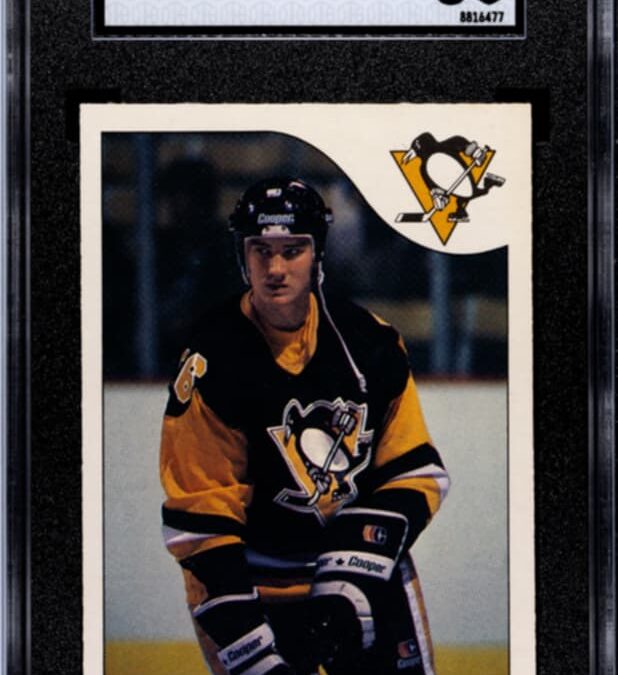OK, maybe crack / resubmit isn’t a full-on craze. But if you’re into vintage and grading, you at least have heard of folks cracking graded cards and resubmitting them. Sometimes a PSA 7 gets cracked and resubmitted in hopes of an 8. Sometimes an SGC 6 gets cracked and resubmitted with the owner hoping for a PSA 7. Etc.
So, why do collectors crack perfectly good slabs only to resubmit them? What is the upside / downside equation? And what impact does this practice have on graded population reports?
What is Crack / Resubmit?
First, a crack / resubmit is exactly what it sounds like. It involves (carefully) breaking an already-graded card from its plastic case, and resubmitting the card to the same grader or a different one as a raw card for grading.
Here’s an example of a card cracked from PSA and resubmitted to SGC:


How is this different from a Crossover?
This is different from a “crossover,” which is when you submit a card in its current plastic to a grader (typically, a different company). In this case you are “crossing over” to a new slab, and perhaps a new grade (higher or lower). People choose this route for a couple of reasons:
- They do not want to crack open the slab and risk damaging the card;
- You can also stipulate a “minimum grade” for the crossover, meaning that it will be returned to you as-is if it would not reach your minimum grade. This means worst-case, you cannot lose the “value” of the current slab and grade.
There are some challenges to crossovers. Eric Drew from SGC submitter Boca Card Subs sums it up this way:
“Grading companies aren’t going to crack out a card unless they’re 100% sure it will meet your minimum grade. They can’t grade it while it’s still in its current slab so you have to either request a minimum grade that’s lower than its current grade, or crack it out yourself before sending it in. If you’re trying to improve the current grade, you definitely have to crack it out first. Otherwise you’re just donating money to the grading company, and this applies to all grading companies.”
So in other words, it’s best to cross over for PC (personal collection) reasons rather than to “increase the value” of a card. In my experience, crossovers are more successful at lower grades, and damn near impossible for 10’s, for example. This has nothing to do with “grader bias” in my opinion and more to do with the fact that it’s hard to evaluate a card through one or more layers of plastic.
Why Do Collectors Crack / Resubmit?
OK, confession: I’ve never cracked to resubmit. I have done a few crossovers from PSA to SGC (PC preference), and in both cases stipulated the same grade or better as a minimum. In both cases, the cards crossed fine. I’ve done this with a PSA 2 (MC) 1955 Topps Clemente rookie (crossed to SGC 2) and a 1954 Topps Banks rookie (PSA 3 to SGC 3). But I’ve never cracked and resubmitted as raw.
There are several possible motivations for doing so, including:
- You think the grader got it wrong;
- You think the current slab / grade might bias the grader;
- The current slab adds no value or possibly even detracts (BCCG).
Most typically, the owner just believes in the card and thinks the grader undergraded the card–or that a different grading company will assess it differently. SGC and PSA have different grading scales and criteria, so it’s not invalid. Some of the differences between the two leading vintage graders are covered here.
An SGC 5 with poor centering might squeak in as a PSA 6, for example. A PSA 5 with a rough-cut edge might fare better at SGC.
What is the Upside?
Obviously, the upside is: a higher grade and more value. Here’s another PSA-to-SGC resubmission:


The downside can be catastrophic for value if you bet big and lose. I once saw a gorgeous old-label SGC 8 Red Heart Mantle that the owner cracked / resubbed to PSA for a shocking 6. Frustrated by the downgrade, he cracked again and resubmitted back to SGC. This time, it came back as Altered / trimmed. Whoops!
What is the Downside?
The results of crack / submit attempts can be all over the place. I’ve always wanted to to a grading experiment like this, but don’t really have free money to play with like Tyler at Market Movers does (affiliate deal: big Market Movers discount for Cardhound readers!). Check out the the results of this complicated grading experiment where the same 2 cards were submitted to all 4 major graders:
Making Sense of the Results
I tend not to think too deeply about the implications of one single crack / resub result. In the context of millions and millions of cards graded, a few stories are statistically insignificant. I’ve seen PSA to SGC go up, down, and sideways. Even PSA resubmitted to PSA can be dramatically different.
The Pele card does not surprise me at all–it’s likely an old grade, and I think the SGC / PSA assessments are right on. BVG as a starting point means that we should be prepared for lower grades. It’s a more lax scale in practice. I’ve seen BVG cross well at times, but mostly -1 or so at minimum.
The Griffey obviously went on a wild ride. I will urge Tyler to resubmit that Griffey to PSA again! That would be an interesting test of the old saying that PSA stands for “Please Submit Again.” And while this is anecdotal, I have seen many puzzlingly low grades from PSA recently. I think it’s reasonable to guess that the card could have been damaged in the process of removal from the CGC case however. Those things are locked down.
But at the very least, the results are interesting and worth careful consideration. The risks and potential rewards of cracking and resubmitting graded cards are very real.
Sadly, I think the results do tend to illustrate a common opinion–which is likely correct–that grading more subjective than it should be.
What is the Impact on Pop Reports?
Tyler does his due diligence here and notifies each grader when a card has been crossed out of their slab. In theory, the grader could then pull the card from their pop reports. The vast majority of folks do not do this, and so many cards exist in multiple pop reports, or even multiple times in the same company’s report.
Due to the nature of the practice (cracking the slab and usually discarding the label), it’s impossible to know for sure. But personally, I’m aware of single examples of some very low-pop cards that account for nearly 50% of the total PSA / SGC reported population. So as a pop report percentage, crack / resubs of low-pop vintage can skew the total population. This means that some cards are even more rare than you think!
PSA has technology now that can fingerprint cards, but this would only negate PSA crack / resubs back to PSA. And this wouldn’t account for the already-massive numbers of single cards that are logged multiple times in various reports.
Let’s Hear Your Stories
How many times have you resubmitted a single card for grading, and what were the various results? If you have any success stories (or horror stories), share them in the comments!








